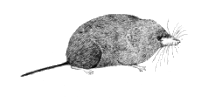The only terrestrial mammals known to echolocate are two genera (Sorex and Blarina) of shrews and the tenrecs of Madagascar. These include the vagrant shrew (Sorex vagrans), the common or Eurasian shrew (Sorex araneus), and the northern short-tailed shrew (Blarina brevicauda). The shrews emit series of ultrasonic squeaks.
The nature of shrew sounds, unlike those of bats, are low amplitude, broadband, multiharmonic and frequency modulated.They contain no "echolocation clicks" with reverberations and would seem to be used for simple, close-range spatial orientation. In contrast to bats, shrews use echolocation only to investigate their habitats rather than additionally to pinpoint food.
Except for large and thus strongly reflecting objects, such as a big stone or tree trunk, they will probably not be able to disentangle echo scenes, but rather derive information on habitat type from the overall call reverberations. This might be comparable to human hearing whether one calls into a beech forest or into a reverberant wine cellar.
